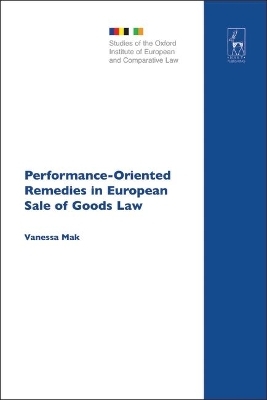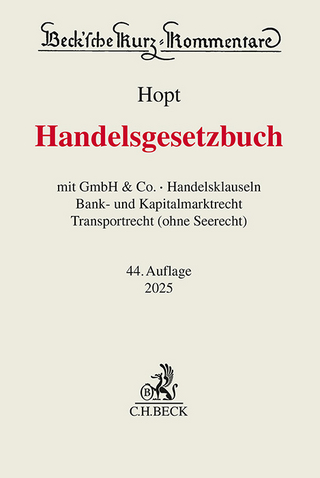
Performance-Oriented Remedies in European Sale of Goods Law
Hart Publishing (Verlag)
978-1-84113-893-0 (ISBN)
Contractual remedies aimed at performance create a well-known rift between common law and civil law traditions, in the one existing in the shadow of damages, whilst in the other regarded as a generally enforceable right following from the contract. Developments in approximation of laws in Europe, in particular in consumer sales law, suggest however that a convergence of these approaches may be within reach. Putting the focus on the contract of sale, which as the most common type of contract may fulfil a leading role in the harmonisation process, this book aims to provide a model for further convergence of European sales laws, engaging with issues of contract theory and comparative law lying at the heart of the process. Independently from this, the comparison between different systems is used in order to highlight particular problems in the remedial schemes of individual systems and to see whether a better solution may be borrowed from elsewhere.
Scaling the interests of sellers and buyers as reflected in national laws as well as in uniform sets of rules such as CISG and PECL, a plea is made for a primary position for performance-oriented remedies in the harmonisation of European sales law. In this context, special significance is attributed to the possibility of cure by the seller, which has both practical and conceptual links to the buyer's remedies aimed at performance.
Vanessa Mak has law degrees from Rotterdam and Oxford, where she also obtained her DPhil. She then lectured at Oriel College, Oxford, and is currently a post-doctoral Fellow at TICOM (Tilburg Institute of Comparative and Transnational Law), the Netherlands.
1-Introduction I. Scope of the Project 1. Jurisdictions and Legal Rules under Consideration 2. Limitations to the Substantive Scope of the Project II. Background and Theoretical Framework 1. The Civilian Tradition: German and Dutch Law 2. The Common Law Tradition: English Law III. Outline of the Project 2-Harmonisation of European Sale of Goods Laws I. Introduction II. Contracts, Sales Contracts and Harmonisation 1. Sales Law and European Contract Law a) Harmonisation of Contract Law in Europe b) Should Sales Law Lead the Way? 2. European Sales Law-The Road Ahead a) Harmonisation of Consumer Sales Law b) CISG and European Sales Law c) PECL or CISG as a Basis for Harmonisation of European Sales Law? 3. Conclusion III. The Boundaries of European Sales Law 1. 'One is More than Two' a) Issues of Delimitation b) A Transaction Costs Approach c) Consumer Protection and Consumer Confidence 2. Harmonisation-An Assessment of the Current Position 3. Conclusion 3-The Nature and Scope of Performance-Oriented Remedies I. Introduction II. The Nature of Performance-oriented Remedies 1. The Binding Nature of Contractual Obligations 2. The Nature of Performance: Rights or Remedies? a) Basic Notion: 'Performance-oriented Remedies' b) 'Discretionary Remedialism' c) Sub-division into Rights and Remedies 3. The Performance Interest Protected through Performance-Oriented Remedies a) The Under-Compensation Argument b) The Intentions of the Parties III. The Scope of Performance-Oriented Remedies 1. Utilitarianism v Rights-Based Theory 2. Limitations Based in Efficiency 3. Limitations Based in Moral Rights Reasoning IV. Conclusion 4-The Buyer's Entitlement to Specific Performance I. Introduction II. The Basis for Specific Performance in English Sale of Goods Law 1. Unique Goods and Section 52 of the SGA 2. Commercial Uniqueness a) Value of the Goods to the Buyer b) Temporary Unavailability of Substitutes c) Quantification of Damages III. A Wider Perspective-Specific Performance in German and Dutch Law 1. General Availability of Specific Performance 2. Limits to Specific Performance-The Other Side of the 'Appropriateness' Test IV. Restrictions on Specific Performance-Common Law and Civil Law Compared 1. English Law Bars to Specific Performance a) Impossibility b) Severe Hardship 2. Civil Law Bars to Specific Performance a) Impossibility b) Good Faith as a Bar to Specific Performance 3. Common Law and Civil Law Restrictions Compared a) Weight Attached to Restrictions on Specific Performance b) Good Faith as a General Restriction on Specific Performance 4. Conclusion V. Specific Performance in European and Other Uniform Sales Laws 1. The Basic Principle-General Availability of Specific Performance 2. Bars to Specific Performance VI. Conclusion 5-Repair and Replacement I. Introduction II. Repair and Replacement: Definitions 1. Repair 2. Replacement III. Repair, Replacement and Specific Performance IV. The Buyer's Freedom of Choice 1. The Choice between Performance-Oriented Remedies, Damages and Termination 2. The Choice between Repair and Replacement V. Restrictions on the Freedom of Choice 1. The Proportionality of the Remedy a) Proportionality and Damages b) Proportionality and Termination or Price Reduction 2. Elements of the Proportionality Test a) Value of the Goods b) Significance of the Lack of Conformity c) Inconvenience to the Buyer 3. Repair and Replacement in Commercial Sales a) The Availability of Repair and Replacement in Commercial Sales b) Restrictions on Repair and Replacement-The Proportionality Test in Commercial Sales VI. Conclusion 6-The Seller's Right to Cure I. Introduction II. Policy Issues III. Cure Before the Due Delivery Date 1. Cure in the Light of the Relationship between the Right to Withhold Performance and the Right of Termination 2. Cure, Tender and Delivery 3. Cure between Rejection and Termination 4. Conclusion IV. Cure after the Due Delivery Date 1. Where Time is of the Essence 2. Where Time is not of the Essence a) Basis of the Right to Cure b) The Time Period for Cure c) Notice or No Notice? 3. Conclusion V. Informal Attempts at Cure 1. The Time Period for Cure 2. Acceptance of Repaired Goods 3. Rejection and Termination Revisited VI. Conclusion 7-Cure: Enforcement, Limitations and the Hierarchy of Remedies I. Introduction II. Enforcement of the Right to Cure 1. The Buyer's Obligation to Take Delivery 2. Safeguards for the Buyer III. Limitations to the Right to Cure 1. Limitations-Cure Compared with Specific Performance 2. Limitations to Cure Based on Moral Rights Reasoning a) 'Unreasonable Expense' b) 'Unreasonable Inconvenience' 3. Conclusion IV. Cure and the Hierarchy of Remedies V. Conclusion 8-Conclusion I. The Buyer's Entitlement to a Performance-Orient
| Erscheint lt. Verlag | 15.1.2009 |
|---|---|
| Reihe/Serie | Studies of the Oxford Institute of European and Comparative Law |
| Verlagsort | Oxford |
| Sprache | englisch |
| Maße | 156 x 234 mm |
| Themenwelt | Recht / Steuern ► EU / Internationales Recht |
| Recht / Steuern ► Wirtschaftsrecht ► Handelsrecht | |
| ISBN-10 | 1-84113-893-2 / 1841138932 |
| ISBN-13 | 978-1-84113-893-0 / 9781841138930 |
| Zustand | Neuware |
| Informationen gemäß Produktsicherheitsverordnung (GPSR) | |
| Haben Sie eine Frage zum Produkt? |
aus dem Bereich


